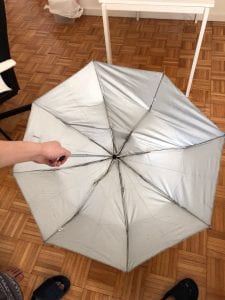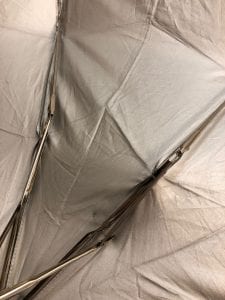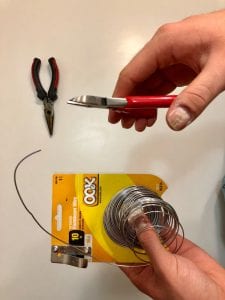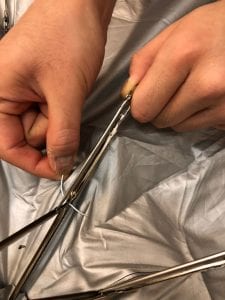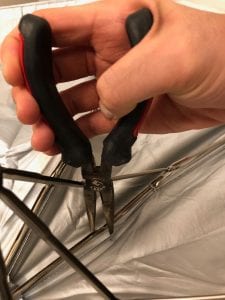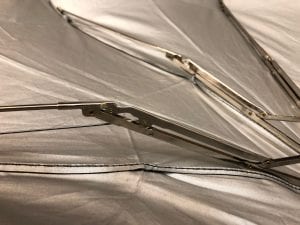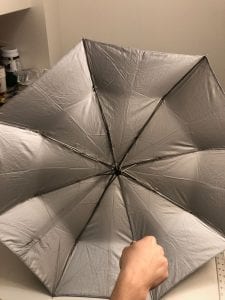1) Complete your Repair project (steps 4-10)
 and post photos of your project on your LP (consider lighting, background etc when documenting) Bring your repair project ready to formally present next week and to explain your process.
and post photos of your project on your LP (consider lighting, background etc when documenting) Bring your repair project ready to formally present next week and to explain your process.
The repair was much better than I initially expected, and I am happy with the result. The repair did not change much of my umbrella’s overall appearance, but the ribs of the umbrella can now form a full circle, instead of a Pac-Man shape. They are now resilient enough to support the overall structure.
I learned that many things can be repaired if people actually care about them and take some time to think about ways to fix them. Before, the damage on my umbrella seemed rather severe; it could not fold and unfold properly, which failed to cover the person underneath from the rain. However, after some observation and trial, I could see that d that it was not that much of a deal of repair it. During the repair, I realized that just from the amount of force I can exert, the overall shape of the umbrella can be changed. Even though it is repaired, I am concerned that it could be damaged anytime if the user is not careful enough. I will try my best for it to last for another year and more. One surprise I encountered was that for this umbrella, the canopy and the ribs are not attached by some adhesive but connected through the thread. Next time, I will try to see if I can find some material that can be used to replace the ribs. A few of them were twisted a lot, so my attempt to turn them back required much force and resulted in some damage that could have weakened them. Now that I learned the possible danger of repairing this way, I could try finding a replacement rib if it is curved too much. I knew that repair is a valuable skill, but after completing this project, I could actually realize its importance. When I first discovered that my umbrella was broken, I automatically assumed that it was beyond repair. I did not really consider repairing as an option and did not pay much attention to why it was broken before this project. Nevertheless, being able to repair gave me a functioning umbrella that I once had lost, and now I do not have to worry about getting a new one on my way out of a subway station next time it rains.
Many ribs, most severely at one side, are curved and twisted, resulting in a collapse of overall structure
One of the screws was missing in one joint, causing the unbalance and overall damage
I inserted a piece of aluminum wire (leftover from another project) at the joint missing a screw so that the ribs can support its structure
Using pliers, I adjusted the twisted and curved shapes of multiple ribs as best as I could
One of the strings that attach the canopy and the ribs was cut, so I sewed that part with a needle placed at home
After repairing, the overall structure of the umbrella is properly supported by the ribs, resulting in a circled shape without any apparent damage.
The most important aspect of making a design easily repairable is decreasing the waste product. In order to create a new product to replace the damaged one, all the materials that the product is composed of have to be retained from other sources. Furthermore, it requires extra energy to put everything together, which is a big waste of resource and energy when one could simply repair a part of it. If there is only a portion of a product that is not functioning, replacing forces people to throw away the whole item including the part that still works without any problem.
The umbrella is relatively small, and all its parts are clearly visible, which makes it easily repairable. However, the objects that contain lots of materials hidden in the internal space and require a special method to open it up to see the inside would be quite difficult to handle. Unfortunately, most of the electronics are in that way, and my old cellphone that could not recognize a touch at the screen was one of them. I would not have to buy a new one if I had the skills to repair it.
Yes, buying a new replacement would require every single material used in making an umbrella: the pole, canopy, ribs, runners, and handle. Producing and assembling those parts together would involve multiple systems such as fabric, metal, accessory, protection, etc. However, replacing only involved my physical strength, small piece of aluminum wire, needle, and thread.
2) How do you as an artist/designer want to skillfully and creatively meet the challenges presented by the Sixth Extinction? How might this approach, differ from your responses to the Great Acceleration and Anthropocene?
The Sixth Extinction results in destruction of the ecosystem and disappearance of many species. In order to alleviate its effect, designers should not only produce items through environmental-friendly materials and methods, but also repeatedly remind others about the seriousness of the issue. There is a limit on how much one could do to face such an enormous problem; even if a designer makes something that can save the resource and promote the growth of ecosystem, if people are not interested or aware of its existence, it is no use. That is why a creative and effective way to inform the public is crucial, and designers can achieve that through their artworks. For example, Maya Lin’s What’s Missing is highly inspiring and capable of grabbing people’s attention.
The focus of the Great Acceleration and Anthropocene is the increased human activity itself, while the Sixth Extinction is the by-product. As a result, the effort to deal with the problems of the Great Acceleration would essentially work for the Sixth Extinction as well. One possible difference could be that while it is easier to experience the extent of human activities in everyday life, the disappearance of species cannot really be recognized by the public unless studied and told. Therefore, the importance of awareness should be little more emphasized for the problems with the Sixth Extinction.
3) Carefully read the following article on Systems Thinking and Mapping. Bring a printed copy with you to class next week for discussion. How does this kind of mapping seems to differ from life cycle design? What questions do you have about five themes of this article — interconnectedness, synthesis, causality, emergence, feedback loops. Can you think of examples of each? How do you think systems thinking relates to sustainable art and design?
While the life cycle design emphasizes different ways that lead to protection and recovery of the environment, the systems thinking provides multiple approaches to view the problem in relation to its surrounding factors. As a result, it is important to creatively arrange the ideas to discover the hidden relationship, which could also lead to more connections that can only be recognized then.
It seems like analysis is the opposite of synthesis, the goal in systems thinking, but I wonder how one would be able to fully understand the complexity without an attempt to break it down to manageable parts. Also, the concept of emergence is difficult to grasp, as the source acknowledges; if a new outcome emerges from the synergies of the individual elements, how does one differentiate it from the results of the synthesis?
One example of interconnectedness could be the TV screen, as the individual red, green, and blue dots form pictures. The natural leather made from Kombucha and sugar water sounds like a synthesis; each one of them by itself would not form the leather. For causality, the forecast and people’s outfit seem to show the dynamic cause and effect. It is difficult to come up with one for the emergence, but my guess is the growth of mold on bread. The rise and fall of the locust swarm is one example of the feedback loop in nature.
With systems thinking, the designers can come up with items that have multiple application and flexible adjustment. The interconnectedness, synthesis, causality, emergence, and feedback loops are applicable in the relationships between the designers, products, users, and the environment. All these factors interact and influence each other to result in something that cannot be easily achievable by oneself. For example, the designers try to analyze the natural phenomena and meet the users’ needs, and the users provide feedback, which leads to an improved outcome. By working together, the artists, artworks, general public, and nature can produce in positive result to all members in the relationship.
4) Learn about Patagonia’s Worn Wear program (Links to an external site.) and FabScrap (Links to an external site.). What is most inspiring to you about these programs? Do you know of others like it? Would you be more likely to buy their clothes after learning about these services?
Personally, the idea of relocating materials from unwanted individuals to someone who demands them grabs my attention. While donations also serve similar roles, these programs provide some compensation for the people who brought the items as well. Also, removing the unwanted or intractable items itself can benefit the donor. I know many organizations that accept donation, like Goodwill and the Salvation Army, but I am not sure if they are doing any similar program. I think learning about these services would increase the chance of me to consider them as an option when I am looking for things. The reputation of the company does affect people’s attitude toward it, so I will likely have positive feeling towards Patagonia and FabScrap for considering the environment. This alone would not make me to purchase their products right away, but next time I am looking for some new clothing, I would probably check if there is any one of them nearby.
5) Start your natural dye project (download protocol if you need it here). What does it feel like to make your own natural dyes?
Making the natural dyes reminds me of the times when I dropped some food and stained my clothing or the tablecloth. Even though the food contacted the surface of fabric for a very brief moment, it often left some colored marks that required multiple washings to remove. Liquid sauce containing some oil was one of the most challenging things to completely get rid of. As a result, I could not help but wonder how difficult it would be to remove the dye extracted from a food source, and I treated them very carefully. Technically, dyeing and staining are the same thing, but people want the former to last permanently while trying to eliminate the latter. I wonder if the fabrics can be made more resistant to the natural dyes while keeping the artificial dyes. Then people would not have to worry about anything as they enjoy eating their delicious food.

